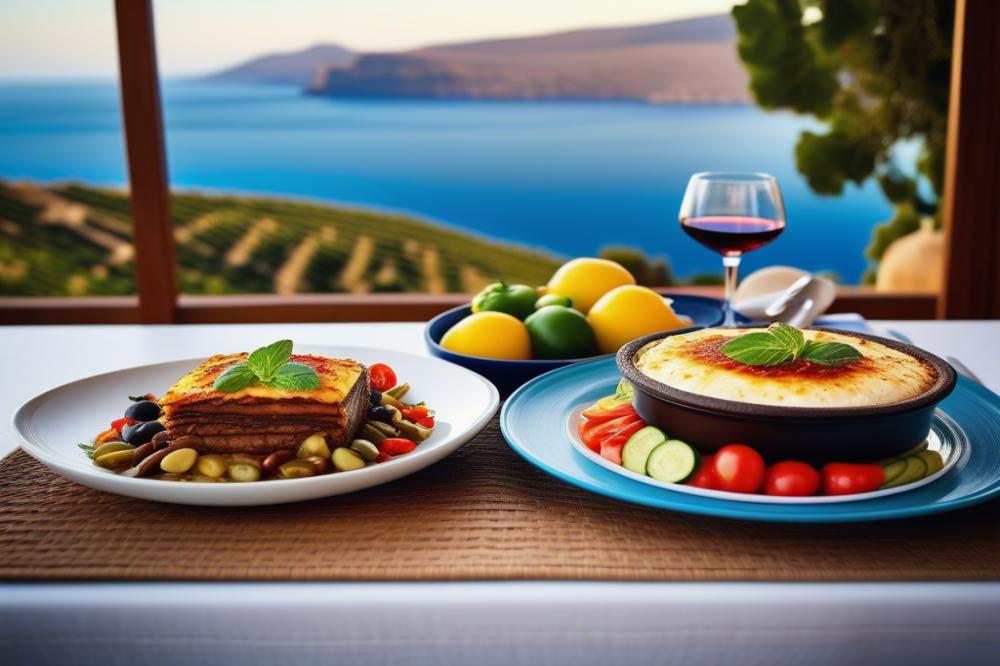Exploring the Unique flavors of Cycladic cuisine
Cycladic cuisine offers a delightful glimpse into the culture and geography of the stunning Cyclades Islands. This culinary tradition stems from an environment shaped by sun, sea, and rugged landscapes. As a result, the flavors are as vivid as the bright white buildings against the azure sky. Local ingredients play a crucial role in defining the tastes found in traditional recipes. Visitors to these islands cannot help but notice the importance of fresh seafood. It holds a special place on many tables, providing a taste of the surrounding Aegean waters.
The use of herbs is another key feature. Rosemary, thyme, and oregano grow abundantly across the hills. These aromatic plants enhance regional dishes, bringing each meal to life. Olive oil, a staple in Mediterranean cooking, is often drizzled generously over various foods. This gives dishes a unique richness while paying homage to time-honored practices. Cheeses crafted from local goat and sheep’s milk add distinct flavors, making meals truly memorable.
Culinary traditions passed down through generations create a connection to the past. Each recipe tells a story, reflecting the island’s history and lifestyle. Community meals serve as gatherings to celebrate both food and friendship. As people share their meals, they also share their culture. The island flavors represented on plates are diverse, influenced by each island’s character and the abundance of ingredients found there.
Overall, Cycladic cuisine captures the spirit of the Greek islands. It showcases the blending of natural resources with human creativity. Every bite reveals something about the land and its people. Explorers of this vibrant culinary landscape will find themselves deeply satisfied as they discover the tastes and traditions that define this remarkable region.
The Essence of Cycladic Cuisine

Cycladic cuisine stands out for its simplicity and heartiness. This culinary style reflects the spirit of the islands. Fresh, seasonal produce plays a vital role in every dish. Local ingredients form the backbone of many traditional recipes. Cooking here celebrates the natural bounty of the land and sea.
Seafood frequently shines on the plates of Cycladic kitchens. Surrounding waters provide an abundance of fish and shellfish. Fishermen bring in their catches daily, ensuring that the flavors remain vibrant and authentic. Meals often feature grilled fish, drizzled with olive oil, accompanied by a squeeze of lemon. Such dishes highlight the freshness that is essential in this culinary tradition.
The use of olive oil cannot be overstated. This golden liquid enhances nearly every dish, adding richness and depth. It also serves as a base for many sauces and marinades. Herbs contribute fragrant notes to the food as well. Oregano, thyme, and dill are commonly used, reflecting the landscape of the islands.
Cheeses hold a cherished place in Cycladic meals. Feta and manouri are popular choices, often enjoyed with a drizzle of olive oil or on a slice of bread. These regional cheeses add creaminess and distinct flavors, perfectly complementing the other elements of the plate.
In summary, Cycladic cuisine emerges from a blend of fresh ingredients, traditional recipes, and time-honored techniques. Emphasizing local produce, dishes embody the island flavors that define this unique culinary landscape. Cooking here is more than just food; it is a reflection of the rich culture and history of the Cyclades.
Seafood in Cycladic Culinary Traditions

The Aegean Sea plays a crucial role in the culinary traditions of the Cyclades. This vast body of water is teeming with flavorsome seafood. Fishermen have relied on its bounty for generations. The local ocean provides everything from octopus to sardines, making seafood a staple on most tables.
Among the traditional recipes, grilled octopus stands out. It is often marinated in olive oil and herbs before grilling, imparting rich island flavors. Another must-try is the fish soup, known locally as “psarosoupa.” This dish is made with fresh catch and often includes regional vegetables and spices, resulting in a comforting and satisfying meal.
Local fishing practices deeply influence the flavors of these dishes. Many fishermen use methods that have not changed for centuries. They employ sustainable techniques, which help maintain fish populations. As a result, the seafood available is fresh and flavorful. Many recipes focus on highlighting the natural taste rather than masking it.
Traditional Cycladic cuisine also incorporates local ingredients like cheeses and herbs. Feta cheese is often sprinkled over seafood dishes, adding a creamy texture. Wild herbs, such as oregano and thyme, are frequently used to season fish, enhancing the overall taste profile. These combined elements create a delightful array of regional dishes that reflect the culture of the islands.
In summary, seafood is more than just a meal in the Cyclades; it is a part of their culinary identity. The flavors brought forth from the Aegean are celebrated in many forms. Whether through grilling or slow simmering, the emphasis is always on freshness. Each plate tells a story of the sea and the traditions that have shaped this beautiful region.
Exploring Traditional Recipes and Regional Dishes

Cycladic cuisine offers a variety of iconic dishes that showcase the flavors of the region. Moussaka is a well-known dish that many people enjoy. It features layers of eggplant, ground meat, and béchamel sauce. Each bite delivers a rich combination of flavors. Fava, often served as a spread, is made from split peas. This creamy dish pairs beautifully with olive oil and lemon. Caper salad highlights local ingredients like fresh capers, tomatoes, and onion. It’s a refreshing addition to any meal.
The preparation of traditional recipes reflects deep-rooted culinary traditions. Chefs often use local ingredients, focusing on what the surrounding land and sea provide. Fresh herbs, such as oregano and thyme, play a significant role in many dishes. These simple yet potent additions elevate the overall taste. Cooking methods vary but often include grilling, baking, or slow-cooking. Each method brings out the natural flavors of the food. Presentation tends to be rustic, allowing the ingredients to shine.
Regional variations add another layer of diversity to Cycladic flavors. Different islands feature distinct tastes and ingredients. For example, seafood is a staple on the coastal islands. Fresh fish and shellfish are readily available, making them essential to many local dishes. On other islands, dishes may lean more heavily on cheeses and vegetables. The differences in preparation and ingredients create a vibrant culinary landscape.
Exploring these regional dishes reveals much about the islands’ history and culture. Each meal tells a story, reflecting the local lifestyle. Knowing why certain ingredients are used helps deepen the appreciation for their flavors. The careful pairing of olive oil with vegetables creates a harmony that locals cherish. Discovering these unique tastes takes one on a journey through the Cycladic landscape and its heritage.
Herbs and Spices: The Flavor Enhancers

When exploring Cycladic cuisine, one cannot overlook the importance of herbs and spices. These ingredients are essential in creating the bold and vibrant island flavors found in many regional dishes. A variety of local ingredients, including thyme, oregano, and rosemary, are staples in the kitchens of the Cyclades. They not only add flavor but also connect the dishes to the land and sea.
Oregano, in particular, is a key player in traditional recipes. It grows wild on the islands and carries a robust aroma. This herb brightens up roasted meats and fresh seafood, showcasing the natural tastes of the ocean. By incorporating such herbs, cooks preserve culinary traditions passed down through generations.
Thyme is another popular herb in the region. Often used to season dishes like slow-cooked lamb or added to stews, thyme offers a subtle earthiness that enhances the meal. Its presence in local dishes highlights the relationship between the land’s bounty and culinary practices.
Sweet and Spicy Combinations
Spices like cinnamon and allspice may also surprise those new to the local culinary scene. These spices, while not as abundant as herbs, contribute depth to sweet and savory dishes alike. For example, cinnamon pairs wonderfully with stewed fruits or savory meats, showcasing a beautiful balance of flavors.
The use of local cheeses is another hallmark of Cycladic meals. Feta or graviera, a hard cheese, often complements dishes seasoned with these herbs and spices. These ingredients create comforting flavors that reflect the island’s agricultural heritage.
Extra virgin olive oil is ubiquitous across the Cyclades. It serves as the base for many dressings and marinades. Quality olive oil, combined with herbs and spices, transforms simple salads into exquisite dishes. This ingredient acts as a binding agent, marrying flavors together and ensuring a delightful experience for the palate.
Culinary Significance
Herbs and spices are not merely for taste; they hold cultural significance in the region. Many families have their own secret blends, which are shared during special occasions. This personal touch adds a layer of intimacy to meals, creating lasting memories.
Seafood dishes, like grilled octopus or stuffed calamari, often get a sprinkle of these herbs, elevating their flavors. Pairing fresh fish with a drizzle of olive oil and a dash of lemon brings out the best in regional dishes.
In summary, herbs and spices are part of the lifeblood of Cycladic cooking. Their presence enhances flavors, enriches traditional recipes, and embodies the essence of the islands. Discovering the preservation of these culinary traditions will deepen one’s appreciation for the unique tastes of the Cyclades.
The Role of Olive Oil in Cycladic Dishes
High-quality olive oil serves as a cornerstone in many Cycladic dishes. This golden liquid brings together flavors in a way that transforms even the simplest meal. An unassuming drizzle can elevate local ingredients, turning a basic salad into a vibrant, refreshing experience. The richness of olive oil from the Cyclades enhances the essence of traditional recipes, encouraging taste buds to awaken.
Choosing the right olive oil involves understanding its characteristics. Look for oils that are cold-pressed. They often provide a robust taste that complements seafood and vegetables beautifully. Pair a fruity olive oil with fresh salads, whereas a more peppery option works well with grilled meats. Experimenting with local cheeses can also reveal delightful combinations. Each pairing can highlight the diverse flavors of the islands.
From ancient times, olive oil has held cultural significance in the Cyclades. It is not just an ingredient; it embodies a way of life. Families gather to produce their own oils, sharing both labor and knowledge. This communal activity fosters bonds and reflects tradition. Daily meals often include stories and experiences, with olive oil being a symbol of hospitality and warmth.
Cooking with olive oil also represents a connection to the land. It mirrors the Mediterranean diet, rich in wholesome ingredients and flavors. Herbs, fresh seafood, and seasonal vegetables take on new personalities when prepared with this key ingredient. Each dish becomes a story of the island’s culinary traditions, drawing from regional dishes and reflecting the lifestyle of those who cherish them.
A Culinary Journey Through the Cyclades
A rich tapestry of flavors awaits those willing to dive into the culinary wonders of the Cyclades. Each island has its distinct offerings, from fresh seafood to locally grown vegetables. These dishes tell a story, reflecting the culture and history of the region. Visitors can savor the essence of the isles through traditional recipes that have been passed down through generations.
Imagine enjoying a plate of fava, with its creamy texture and earthy notes, paired with a drizzle of olive oil. Or perhaps indulging in a fresh salad crafted from ripe tomatoes, cucumbers, and aromatic herbs. Each bite transports you to sun-soaked landscapes, where simple ingredients create blissful moments. Exploring these dishes goes beyond just eating. It’s about connecting with the land and the people who call it home.
Appreciating this cuisine encourages a deeper understanding of the environment and its resources. Supporting local farmers and fishermen helps preserve these culinary traditions. By valuing what is offered, we contribute to a sustainable future for the islands. Those who partake in this adventure will surely find themselves transformed by the experience.
In closing, an exploration of the culinary offerings of the Cyclades reveals much more than just food. The importance of maintaining these practices can’t be overstated for future generations. Embracing the local ingredients and flavors not only enriches our palate but also nurtures the culture surrounding us. So, embark on this culinary quest, and discover the stories and tastes waiting for you on these enchanting islands.



